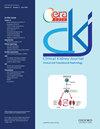丹麦国家患者资料库中活检确诊肾病的病理学代码的有效性
IF 3.9
2区 医学
Q1 UROLOGY & NEPHROLOGY
引用次数: 0
摘要
引言 本研究验证了用于以编码形式描述丹麦医学肾脏活检的《医学系统命名法》第二版(SNOMED II)代码的应用,旨在为有关肾脏疾病的病因、治疗和预后的流行病学研究提供有力支持。方法 使用 SNOMED 代码从丹麦国家 Patobank 中随机提取 1998 年 1 月 1 日至 2018 年 12 月 31 日的肾活检报告。抽取5%的样本,由肾病专家评估相应的医疗记录,为每个病例指定适用的临床诊断。计算了检索到的 SNOMED 代码的敏感性、特异性、阳性预测值 (PPV)、阴性预测值 (NPV) 和科恩卡帕系数 (κ)。结果 共纳入 613 例肾脏活组织检查。主要临床疾病分组为肾小球疾病(368 例)、肾小管间质疾病(67 例)、肾血管疾病(51 例)、糖尿病肾病(51 例)和各种肾脏疾病(40 例)。使用多个 SNOMED 代码来描述每组临床疾病,合并 SNOMED 代码后,肾小球疾病(94%)、糖尿病肾病(85%)和影响肾脏的全身性疾病(96%)的 PPV 很高。相反,肾小管间质疾病(62%)、肾血管疾病(60%)和其他肾脏疾病(17%)的 PPV 值较低。结论与展望 SNOMED 代码对肾小球疾病、糖尿病肾病和影响肾脏的全身性疾病具有较高的 PPV 值,可用于未来的流行病学研究。本文章由计算机程序翻译,如有差异,请以英文原文为准。
The validity of pathology codes for biopsy-confirmed kidney disease in the Danish National Patobank
Introduction This study validates the application of Systematized Nomenclature of Medicine second edition (SNOMED II) codes used to describe medical kidney biopsies in Denmark in encoded form, aiming to support robust epidemiological research on the causes, treatments, and prognosis of kidney diseases. Methods Kidney biopsy reports from January 1st, 1998, to December 31st, 2018, were randomly extracted from the Danish National Patobank, using SNOMED codes. A 5% sample was selected, and nephrologists assessed the corresponding medical records, assigning each case the applied clinical diagnoses. Sensitivity, specificity, positive predictive values (PPV), negative predictive values (NPV), and Cohen's kappa coefficient (κ) for the retrieved SNOMED codes were calculated. Results A total of 613 kidney biopsies were included. The primary clinical disease groups were glomerular disease (n = 368), tubulointerstitial disease (n = 67), renal vascular disease (n = 51), diabetic nephropathy (n = 51), and various renal disorders (n = 40). Several SNOMED codes were used to describe each clinical disease group and PPV for the combined SNOMED codes were high for glomerular disease (94%), diabetic nephropathy (85%), and systemic diseases affecting the kidney (96%). Conversely, tubulointerstitial disease (62%), renal vascular disease (60%), and other renal disorders (17%) showed lower PPVs. Conclusion and perspective SNOMED codes have a high PPV for glomerular diseases, diabetic nephropathy, and systemic diseases affecting the kidney, in which they could be applied for future epidemiological research.
求助全文
通过发布文献求助,成功后即可免费获取论文全文。
去求助
来源期刊

Clinical Kidney Journal
Medicine-Transplantation
CiteScore
6.70
自引率
10.90%
发文量
242
审稿时长
8 weeks
期刊介绍:
About the Journal
Clinical Kidney Journal: Clinical and Translational Nephrology (ckj), an official journal of the ERA-EDTA (European Renal Association-European Dialysis and Transplant Association), is a fully open access, online only journal publishing bimonthly. The journal is an essential educational and training resource integrating clinical, translational and educational research into clinical practice. ckj aims to contribute to a translational research culture among nephrologists and kidney pathologists that helps close the gap between basic researchers and practicing clinicians and promote sorely needed innovation in the Nephrology field. All research articles in this journal have undergone peer review.
 求助内容:
求助内容: 应助结果提醒方式:
应助结果提醒方式:


